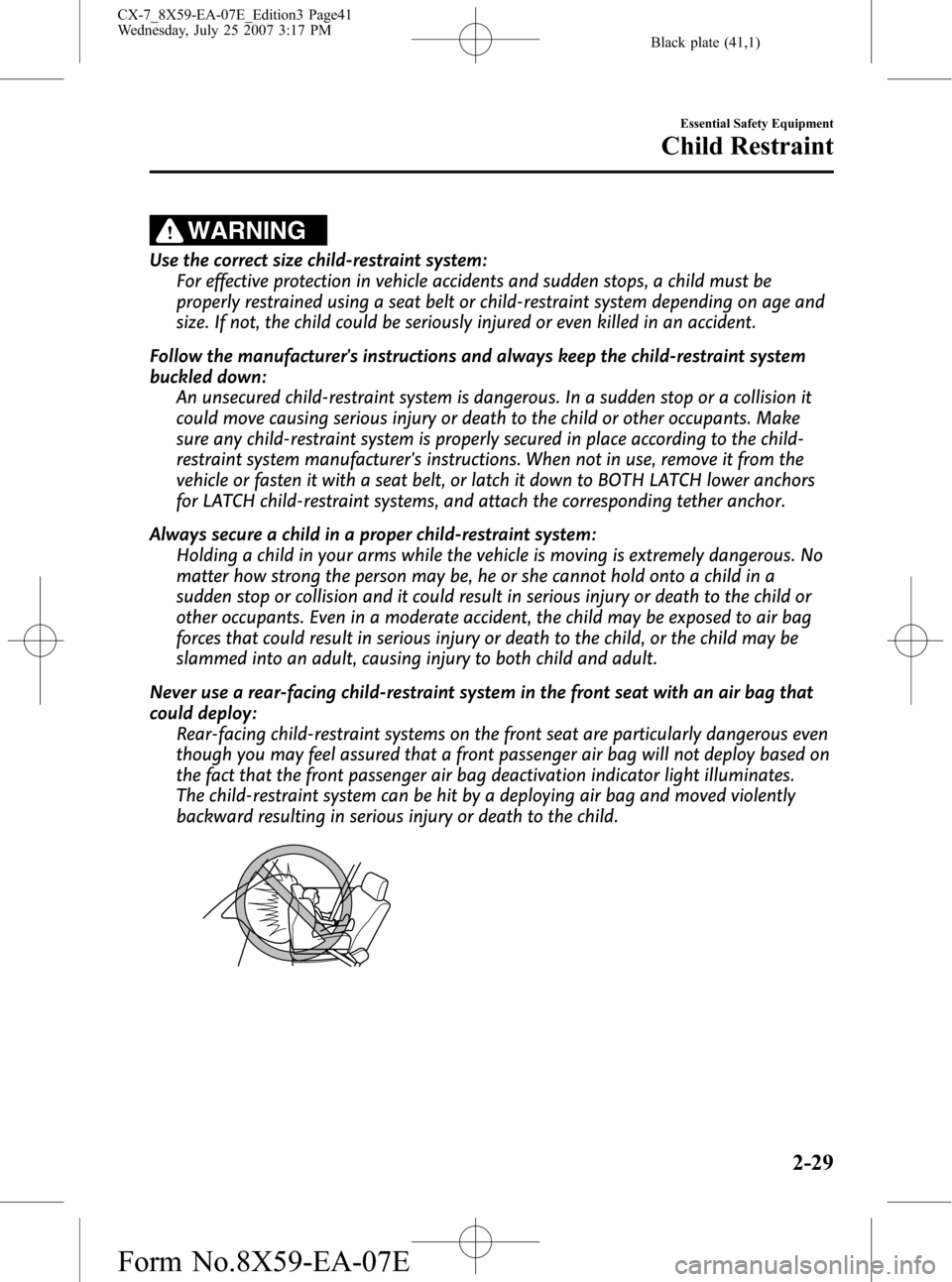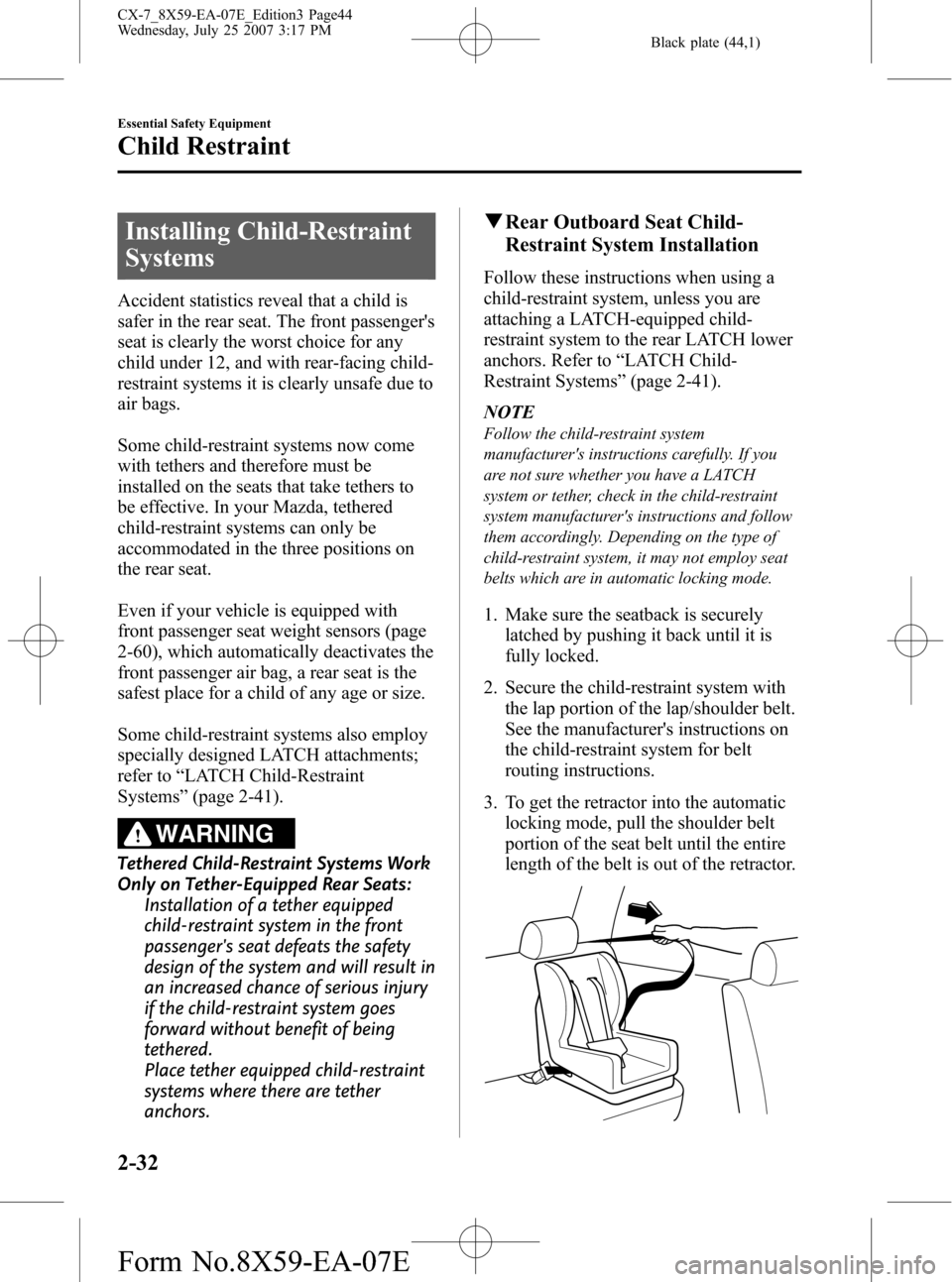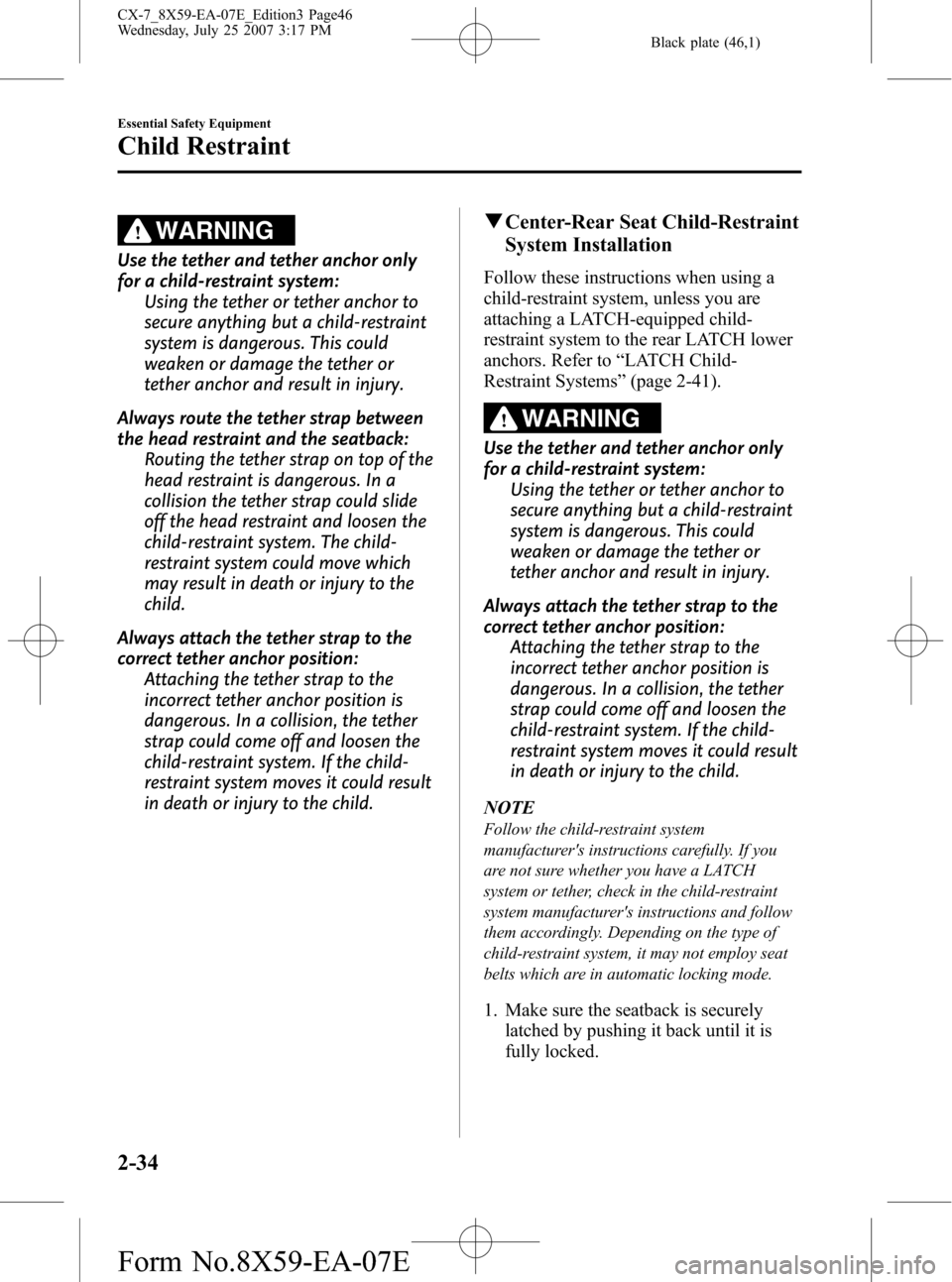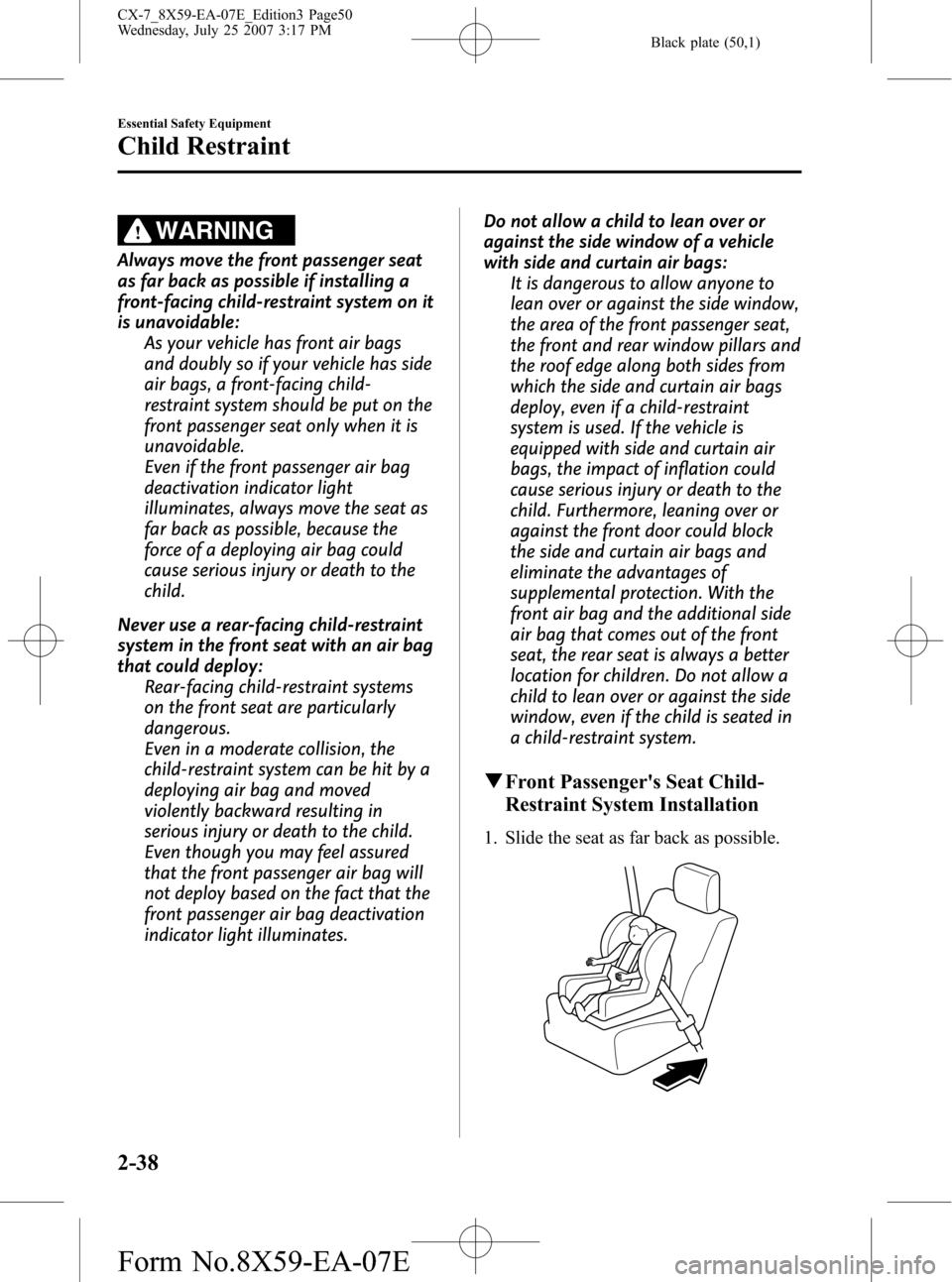warning MAZDA MODEL CX-7 2008 (in English) Owner's Manual
[x] Cancel search | Manufacturer: MAZDA, Model Year: 2008, Model line: MODEL CX-7, Model: MAZDA MODEL CX-7 2008Pages: 502, PDF Size: 10.53 MB
Page 38 of 502

Black plate (38,1)
Seat Belt Warning Light/Beep
The seat belt warning light illuminates
and a beep sound will be heard if the
driver's seat belt is not fastened when the
ignition switch is turned to the ON
position.
Conditions of operation
ConditionResult
The driver's seat belt is not
fastened when the ignition
switch is turned to the ON
position. The warning light
flashes and a beep
sound will be heard
for about 6 seconds.
The driver's seat belt is
fastened while the warning
light and the beep sound are
activated. The warning light
turns off and the beep
sound stops.
The driver's seat belt is
fastened before the ignition
switch is turned to the ON
position. The warning light will
not illuminate and the
beep sound will not be
heard.
q
Belt Minder
NOTE
The belt minder can be deactivated. Consult an
Authorized Mazda Dealer to deactivate and
restore the seat belt minder.
Driver seated/Front passenger not
seated
The belt minder is a supplemental
warning to the seat belt warning function.
If the driver's seat belt is not fastened
when the ignition switch is turned to the
ON position, the warning light/beep
operates to give you further reminders
according to the chart below.
Condition Vehicle speed
Between 0 ―20
km/h
(0 ― 12 mph) 20 km/h
(12 mph) or
more
Seat belt
Indicator
Beep
: Fastened: Unfastened: Illuminated: Flashing: Beep
Once the beep sound is heard, it continues
sounding even if the vehicle speed lowers
to 20 km/h (12 mph) or less until the
seatbelt is fastened or the beep sound
period has passed.
2-26
Essential Safety Equipment
Seat Belt Systems
CX-7_8X59-EA-07E_Edition3 Page38
Wednesday, July 25 2007 3:17 PM
Form No.8X59-EA-07E
Page 39 of 502

Black plate (39,1)
Driver seated/Front passenger seated
The seat belt warning function reminds
the front passenger to fasten the seat belt
according to the chart below.
ConditionVehicle speed
Between 0 ―20
km/h
(0 ― 12 mph) 20 km/h
(12 mph) or more
Seat belt
(Driver)
Seat belt
(Passenger)
Indicator
Beep
: Fastened: Unfastened: Illuminated: Flashing: Beep
Placing heavy items on the front
passenger seat may cause the front
passenger seat belt warning function to
operate depending on the weight of the
item.
Once the beep sound is heard, it continues
sounding even if the vehicle speed lowers
to 20 km/h (12 mph) or less until the
seatbelt is fastened or the beep sound
period has passed.
NOTE
lTo allow the front passenger seat weight
sensor to function properly, do not place
and sit on an additional seat cushion on the
front passenger seat. The sensor may not
function properly because the additional
seat cushion could cause sensor
interference.
lWhen a small child sits on the front
passenger seat, it is possible that neither
the warning light nor the warning beep
operate.
Essential Safety Equipment
Seat Belt Systems
2-27
CX-7_8X59-EA-07E_Edition3 Page39
Wednesday, July 25 2007 3:17 PM
Form No.8X59-EA-07E
Page 41 of 502

Black plate (41,1)
WARNING
Use the correct size child-restraint system:For effective protection in vehicle accidents and sudden stops, a child must be
properly restrained using a seat belt or child-restraint system depending on age and
size. If not, the child could be seriously injured or even killed in an accident.
Follow the manufacturer's instructions and always keep the child-restraint system
buckled down: An unsecured child-restraint system is dangerous. In a sudden stop or a collision it
could move causing serious injury or death to the child or other occupants. Make
sure any child-restraint system is properly secured in place according to the child-
restraint system manufacturer's instructions. When not in use, remove it from the
vehicle or fasten it with a seat belt, or latch it down to BOTH LATCH lower anchors
for LATCH child-restraint systems, and attach the corresponding tether anchor.
Always secure a child in a proper child-restraint system: Holding a child in your arms while the vehicle is moving is extremely dangerous. No
matter how strong the person may be, he or she cannot hold onto a child in a
sudden stop or collision and it could result in serious injury or death to the child or
other occupants. Even in a moderate accident, the child may be exposed to air bag
forces that could result in serious injury or death to the child, or the child may be
slammed into an adult, causing injury to both child and adult.
Never use a rear-facing child-restraint system in the front seat with an air bag that
could deploy: Rear-facing child-restraint systems on the front seat are particularly dangerous even
though you may feel assured that a front passenger air bag will not deploy based on
the fact that the front passenger air bag deactivation indicator light illuminates.
The child-restraint system can be hit by a deploying air bag and moved violently
backward resulting in serious injury or death to the child.
Essential Safety Equipment
Child Restraint
2-29
CX-7_8X59-EA-07E_Edition3 Page41
Wednesday, July 25 2007 3:17 PM
Form No.8X59-EA-07E
Page 44 of 502

Black plate (44,1)
Installing Child-Restraint
Systems
Accident statistics reveal that a child is
safer in the rear seat. The front passenger's
seat is clearly the worst choice for any
child under 12, and with rear-facing child-
restraint systems it is clearly unsafe due to
air bags.
Some child-restraint systems now come
with tethers and therefore must be
installed on the seats that take tethers to
be effective. In your Mazda, tethered
child-restraint systems can only be
accommodated in the three positions on
the rear seat.
Even if your vehicle is equipped with
front passenger seat weight sensors (page
2-60), which automatically deactivates the
front passenger air bag, a rear seat is the
safest place for a child of any age or size.
Some child-restraint systems also employ
specially designed LATCH attachments;
refer to“LATCH Child-Restraint
Systems ”(page 2-41).
WARNING
Tethered Child-Restraint Systems Work
Only on Tether-Equipped Rear Seats:
Installation of a tether equipped
child-restraint system in the front
passenger's seat defeats the safety
design of the system and will result in
an increased chance of serious injury
if the child-restraint system goes
forward without benefit of being
tethered.
Place tether equipped child-restraint
systems where there are tether
anchors.
qRear Outboard Seat Child-
Restraint System Installation
Follow these instructions when using a
child-restraint system, unless you are
attaching a LATCH-equipped child-
restraint system to the rear LATCH lower
anchors. Refer to “LATCH Child-
Restraint Systems ”(page 2-41).
NOTE
Follow the child-restraint system
manufacturer's instructions carefully. If you
are not sure whether you have a LATCH
system or tether, check in the child-restraint
system manufacturer's instructions and follow
them accordingly. Depending on the type of
child-restraint system, it may not employ seat
belts which are in automatic locking mode.
1. Make sure the seatback is securely latched by pushing it back until it is
fully locked.
2. Secure the child-restraint system with the lap portion of the lap/shoulder belt.
See the manufacturer's instructions on
the child-restraint system for belt
routing instructions.
3. To get the retractor into the automatic locking mode, pull the shoulder belt
portion of the seat belt until the entire
length of the belt is out of the retractor.
2-32
Essential Safety Equipment
Child Restraint
CX-7_8X59-EA-07E_Edition3 Page44
Wednesday, July 25 2007 3:17 PM
Form No.8X59-EA-07E
Page 46 of 502

Black plate (46,1)
WARNING
Use the tether and tether anchor only
for a child-restraint system:Using the tether or tether anchor to
secure anything but a child-restraint
system is dangerous. This could
weaken or damage the tether or
tether anchor and result in injury.
Always route the tether strap between
the head restraint and the seatback: Routing the tether strap on top of the
head restraint is dangerous. In a
collision the tether strap could slide
off the head restraint and loosen the
child-restraint system. The child-
restraint system could move which
may result in death or injury to the
child.
Always attach the tether strap to the
correct tether anchor position: Attaching the tether strap to the
incorrect tether anchor position is
dangerous. In a collision, the tether
strap could come off and loosen the
child-restraint system. If the child-
restraint system moves it could result
in death or injury to the child.
qCenter-Rear Seat Child-Restraint
System Installation
Follow these instructions when using a
child-restraint system, unless you are
attaching a LATCH-equipped child-
restraint system to the rear LATCH lower
anchors. Refer to “LATCH Child-
Restraint Systems ”(page 2-41).
WARNING
Use the tether and tether anchor only
for a child-restraint system:
Using the tether or tether anchor to
secure anything but a child-restraint
system is dangerous. This could
weaken or damage the tether or
tether anchor and result in injury.
Always attach the tether strap to the
correct tether anchor position: Attaching the tether strap to the
incorrect tether anchor position is
dangerous. In a collision, the tether
strap could come off and loosen the
child-restraint system. If the child-
restraint system moves it could result
in death or injury to the child.
NOTE
Follow the child-restraint system
manufacturer's instructions carefully. If you
are not sure whether you have a LATCH
system or tether, check in the child-restraint
system manufacturer's instructions and follow
them accordingly. Depending on the type of
child-restraint system, it may not employ seat
belts which are in automatic locking mode.
1. Make sure the seatback is securely latched by pushing it back until it is
fully locked.
2-34
Essential Safety Equipment
Child Restraint
CX-7_8X59-EA-07E_Edition3 Page46
Wednesday, July 25 2007 3:17 PM
Form No.8X59-EA-07E
Page 50 of 502

Black plate (50,1)
WARNING
Always move the front passenger seat
as far back as possible if installing a
front-facing child-restraint system on it
is unavoidable:As your vehicle has front air bags
and doubly so if your vehicle has side
air bags, a front-facing child-
restraint system should be put on the
front passenger seat only when it is
unavoidable.
Even if the front passenger air bag
deactivation indicator light
illuminates, always move the seat as
far back as possible, because the
force of a deploying air bag could
cause serious injury or death to the
child.
Never use a rear-facing child-restraint
system in the front seat with an air bag
that could deploy: Rear-facing child-restraint systems
on the front seat are particularly
dangerous.
Even in a moderate collision, the
child-restraint system can be hit by a
deploying air bag and moved
violently backward resulting in
serious injury or death to the child.
Even though you may feel assured
that the front passenger air bag will
not deploy based on the fact that the
front passenger air bag deactivation
indicator light illuminates. Do not allow a child to lean over or
against the side window of a vehicle
with side and curtain air bags:
It is dangerous to allow anyone to
lean over or against the side window,
the area of the front passenger seat,
the front and rear window pillars and
the roof edge along both sides from
which the side and curtain air bags
deploy, even if a child-restraint
system is used. If the vehicle is
equipped with side and curtain air
bags, the impact of inflation could
cause serious injury or death to the
child. Furthermore, leaning over or
against the front door could block
the side and curtain air bags and
eliminate the advantages of
supplemental protection. With the
front air bag and the additional side
air bag that comes out of the front
seat, the rear seat is always a better
location for children. Do not allow a
child to lean over or against the side
window, even if the child is seated in
a child-restraint system.
qFront Passenger's Seat Child-
Restraint System Installation
1. Slide the seat as far back as possible.
2-38
Essential Safety Equipment
Child Restraint
CX-7_8X59-EA-07E_Edition3 Page50
Wednesday, July 25 2007 3:17 PM
Form No.8X59-EA-07E
Page 52 of 502

Black plate (52,1)
WARNING
Do not seat a child in a child-restraint
system on the front passenger seat if
the front passenger air bag
deactivation indicator light does not
illuminated:While it is always better to install any
child-restraint system on the rear
seat, it is imperative that a child-
restraint system ONLYbe used on the
front passenger seat if the
deactivation indicator light
illuminates when the child is seated
in the child-restraint system (page
2-60). Seating a child in a child-
restraint system installed on the front
passenger seat with the front
passenger air bag deactivation
indicator light not illuminated is
dangerous. If this indicator light does
not illuminate even when the total
seated weight is less than
approximately 30 kg (66 lb), this
means that the front passenger front
and side air bags, and seat belt
pretensioner are ready for
deployment. If an accident were to
deploy an air bag, a child in a child-
restraint system sitting in the front
passenger seat could be seriously
injured or killed. If the indicator light
does not illuminate after seating a
child in a child-restraint system on
the front passenger seat, seat a child
in a child-restraint system on the rear
seat and consult an Authorized
Mazda Dealer as soon as possible.
2-40
Essential Safety Equipment
Child Restraint
CX-7_8X59-EA-07E_Edition3 Page52
Wednesday, July 25 2007 3:17 PM
Form No.8X59-EA-07E
Page 53 of 502

Black plate (53,1)
LATCH Child-Restraint Systems
Your Mazda is equipped with LATCH lower anchors for attachment of specially designed
LATCH child-restraint systems in the rear seat. Both anchors must be used, otherwise the
seat will bounce around and put the child in danger. Most LATCH child-restraint systems
must also be used in conjunction with a tether to be effective. If they have a tether you
must use it to better assure your child's safety.
WARNING
Follow the manufacturer's instructions for the use of the child-restraint system:An unsecured child-restraint system is dangerous. In a sudden stop or a collision it
could move causing serious injury or death to the child or other occupants. Make
sure the child-restraint system is properly secured in place according to the child-
restraint system manufacturer's instructions.
Never attach two child-restraint systems to the same LATCH lower anchor: Attaching two child-restraint systems to the same LATCH lower anchor is dangerous.
In a collision, one anchor may not be strong enough to hold two child-restraint
system attachments, and it may break, causing serious injury or death. If you use the
seat position for another child-restraint system when an outboard LATCH position is
occupied, use the center seat belts instead, and the tether if tether-equipped.
Make sure the child-restraint system is properly secured: An unsecured child-restraint system is dangerous. In a sudden stop or a collision it
could move causing serious injury or death to the child or other occupants. Follow
the child-restraint system manufacturer's instructions on belt routing to secure the
seat just as you would with a child in it so that nobody is tempted to put a child in
an improperly secured seat later on. When not in use, remove it from the vehicle or
fasten it with a seat belt, or latch it down to BOTH LATCH lower anchors for LATCH
child-restraint systems.
Make sure there are no seat belts or foreign objects near or around the LATCH child-
restraint system: Not following the child-restraint system manufacturer's instructions when installing
the child-restraint system is dangerous. If seat belts or a foreign object prevent the
child-restraint system from being securely attached to the LATCH lower anchors and
the child-restraint system is installed improperly, the child-restraint system could
move in a sudden stop or collision causing serious injury or death to the child or
other occupants. When installing the child-restraint system, make sure there are no
seat belts or foreign objects near or around the LATCH lower anchors. Always follow
the child-restraint system manufacturer's instructions.
Essential Safety Equipment
Child Restraint
2-41
CX-7_8X59-EA-07E_Edition3 Page53
Wednesday, July 25 2007 3:17 PM
Form No.8X59-EA-07E
Page 55 of 502

Black plate (55,1)
WARNING
Use the tether and tether anchor only
for a child-restraint system:Using the tether or tether anchor to
secure anything but a child-restraint
system is dangerous. This could
weaken or damage the tether or
tether anchor and result in injury.
Always route the tether strap between
the head restraint and the seatback: Routing the tether strap on top of the
head restraint is dangerous. In a
collision the tether strap could slide
off the head restraint and loosen the
child-restraint system. The child-
restraint system could move which
may result in death or injury to the
child.
Always attach the tether strap to the
correct tether anchor position: Attaching the tether strap to the
incorrect tether anchor position is
dangerous. In a collision, the tether
strap could come off and loosen the
child-restraint system. If the child-
restraint system moves it could result
in death or injury to the child.
qChild-Restraint System Installation
Procedure (Center-Rear Seat)
The LATCH lower anchors at the center
of the rear seat are much further apart than
the sets of LATCH lower anchors for
child-restraint system installation at other
seating positions. Child-restraint systems
with rigid LATCH attachments cannot be
installed on the center seating position.
Some LATCH equipped child-restraint
systems can be placed in the center
position and will reach the nearest
LATCH lower anchors which are 400 mm
(15.75 in) apart. LATCH compatible
child-restraint systems (with attachments
on belt webbing) can be used at this
seating position only if the child-restraint
system manufacturer's instructions state
that the child-restraint system can be
installed to LATCH lower anchors that are
400 mm (15.75 in) apart. Do not attach
two child-restraint systems to the same
LATCH lower anchor. If your child-
restraint system has a tether, it must also
be used for your child's optimum safety.
Essential Safety Equipment
Child Restraint
2-43
CX-7_8X59-EA-07E_Edition3 Page55
Wednesday, July 25 2007 3:17 PM
Form No.8X59-EA-07E
Page 56 of 502

Black plate (56,1)
WARNING
Use the tether and tether anchor only
for a child-restraint system:Using the tether or tether anchor to
secure anything but a child-restraint
system is dangerous. This could
weaken or damage the tether or
tether anchor and result in injury.
Always attach the tether strap to the
correct tether anchor position: Attaching the tether strap to the
incorrect tether anchor position is
dangerous. In a collision, the tether
strap could come off and loosen the
child-restraint system. If the child-
restraint system moves it could result
in death or injury to the child.
1. Make sure the seatback is securely latched by pushing it back until it is
fully locked.
2. Expand the open seams on the rear of the seat bottom slightly to verify the
locations of the LATCH lower anchors.
NOTE
The markings above the LATCH lower anchors
indicate the locations of LATCH lower
anchors for the attachment of a child-restraint
system.
3. Secure the child-restraint system usingBOTH LATCH lower anchors,
following the child-restraint system
manufacturer's instructions.
Type A
1. If your child-restraint system came
equipped with a tether, that probably
means it is very important to properly
secure the tether for child safety. First,
remove the anchor bracket cover on the
rear end trim.
2. Flip over the trunk board.
Trunk board
2-44
Essential Safety Equipment
Child Restraint
CX-7_8X59-EA-07E_Edition3 Page56
Wednesday, July 25 2007 3:17 PM
Form No.8X59-EA-07E